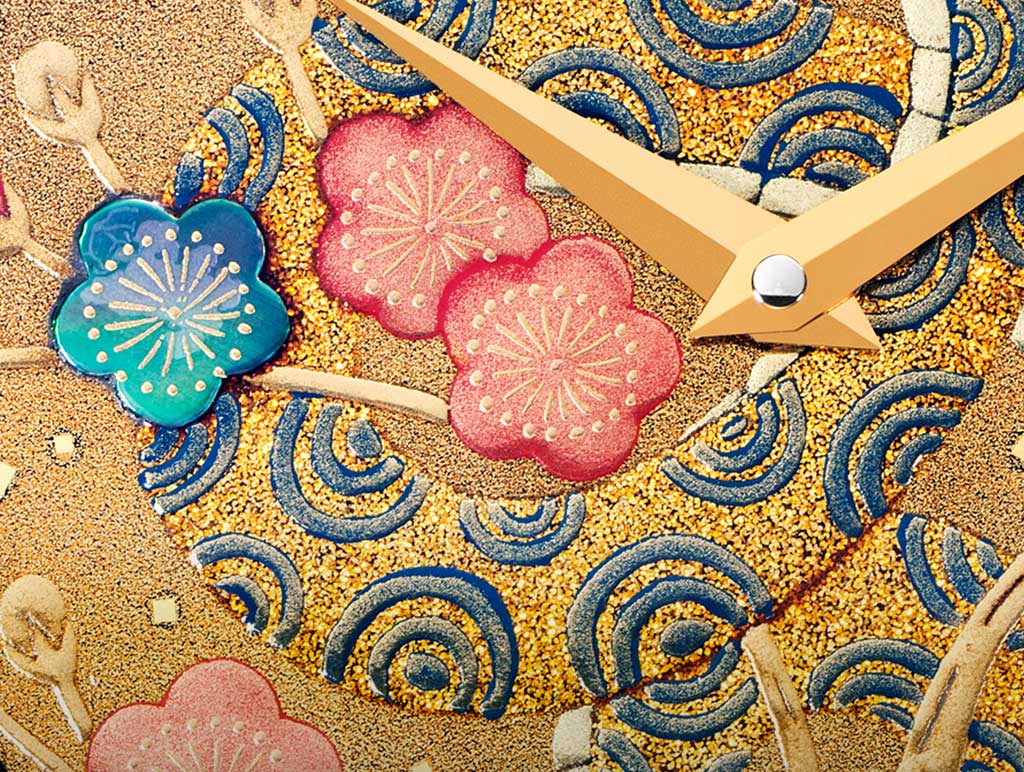When Japanese Lacquer Technique Is Applied to Watches
Chopard
The complex Japanese lacquering technique known as maki-e is often found on luxury pens, but only a few companies have applied it to watch dials. Nevertheless, this year Vacheron Constantin, Van Cleef & Arpels and Chopard have all teamed up with Japanese maki-e masters to release limited-edition watches.
Maki-e, which translates as “sprinkled picture,” is a traditional multilayered lacquering method in which fine colored or precious metal dust, often silver and gold, is sprinkled to form a design or picture on a lacquer surface while it is still wet. This decorative technique uses a rare varnish-tree lacquer that acts as a protective, clear glue between each successive layer, giving the finished scene depth and perspective.
Zohiko, based in Kyoto, is a 300-year-old maker of fine lacquer ware that collaborated with Vacheron Constantin to create its first lacquer collection. The process included the application of urushi, the name of the clear lacquer used in maki-e, and yakituke, a hot lacquering process.
“Painting urushi onto the metal directly is difficult, so we’ve used the technique called yakituke,” said Nishimura Hikobei, director of Zohiko.
The lacquer collection, “The Three Friends of Winter,” is a limited edition set of three watches, decorated with pine tree, bamboo, and plum tree designs, all symbolizing longevity and loyal friendship in the face of adversity. Each watch has a double face, lacquered using the maki-e technique. The main design of the tree on the front of the watch is matched by a bird design on the back, facing the wrist. The pine is matched with a crane, the bamboo with a sparrow, and the plum tree with a nightingale.
Christian Selmoni, artistic director at Vacheron Constantin, said all of the first year’s 20 sets were reserved by clients around the world after the collection was introduced in January. Each set sells in Singapore for 435,000 Singapore dollars, or about $330,000.
Chopard
While watchmakers have been using enameling techniques like cloisonné and champlevé on their dials to great effect for decades, they have largely stayed clear of lacquer until fairly recently. This year, Chopard introduced its first “L.U.C. XP Urushi” collection. Van Cleef also released a limited edition of eight maki-e watches, “Midnight Extraordinary Japanese Lacquer,” inspired by traditional Japanese landscapes.
“It’s not the first time we’re having these watches, but this year we have a particularly large collection,” said Jonathan King, general manager for Southeast Asia at Van Cleef & Arpels. Mr. King said there was “a cluster” of worldwide clients that showed interest in this type of watch, “not just Japanese.”
“It’s really for true connoisseurs,” he said. “It’s like looking at a painting under glass.”
Peter Speake-Marin, an independent watchmaker, has also, since 2007, been working primarily with a Japanese Maki-e artist, Muysu Yamazaki, who has crafted eight of these time-consuming faces for him.
“If you want to achieve depth, you have to build up many layers, and each has to dry over a two-day period,” Mr. Speake-Marin said. “The whole process for these watches is extremely time consuming.”
“I have sold as many to the U.S. as to Japan,” he added. “If something is beautiful, it is appreciated by collectors of all nationalities, possibly more so outside of Asia because it is more exotic.”
Other lacquer techniques are also being used on dials. Angular Momentum, a Swiss company that specializes in custom-made timepieces, started doing lacquer dials in 2004.
Angular Momentum pieces done by Marin Pauli mainly use the taka-maki-e technique, lacquer decoration in bold reliefs, which is then mixed with other modern techniques and designs like guilloché or floral engraving. The company has also produced so-called tsuishu dials, where the lacquer is engraved.
Since it works mainly with stainless steel watch cases, prices for the lacquer watches start relatively low, at around 12,000 Swiss francs, or about $12,000.
“I have personally made about 70 timepieces with various lacquer techniques in the past years,” Mr. Pauli said. “Most have been custom made for our customers in the Middle East.”
He added: “The executions have not been works in the traditional Japanese way but often mixtures of techniques according to the customers’ taste and ideas.”
A version of this article appears in print on November 26, 2010, in The International Herald Tribune.

